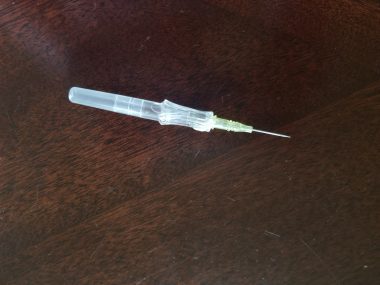I Don’t Like Needles, but They’re Part of My Life With NMO
Written by |

Tests, treatments, and medical procedures are important, but they can be a hassle and are sometimes painful. I don’t always know what to expect, which creates anxiety, especially if a needle is involved.
As a neuromyelitis optica (NMO) patient, I have had bloodwork, MRIs, and spinal taps, and I receive treatment via infusions. All of these procedures require the use of a needle. I do not like needles. They are not my friends.

A souvenir from my last infusion. (Photo by Mileidys Almaguer)
I have small arms and small veins. Some nurses have said my veins are hard to find, while others have found them right away. It’s a mystery who is right.
Staff at the infusion center where I go for my NMO treatment often has a hard time finding my veins, too. After poking me a few times, my nurse usually has to fetch someone more skilled. It’s a good thing my infusion at the hospital is only every six months.
I’m grateful the nurse who comes to my house to deliver monthly infusions is excellent. She finds my vein right away. During my brief time as a student in a registered nurse program, I was surprised to learn that the program doesn’t teach students how to place an IV. We learn on the job. Maybe that is why I have been tortured a few times!
Despite the torture of needles, I’ve gotten used to them. I had no choice. My routine blood test requires a needle to draw blood to be analyzed in a lab.
A spinal tap requires a big needle to be inserted into the lower back to extract cerebrospinal fluid. This procedure is done to help diagnose NMO. Fortunately, because I have my diagnosis, I don’t need to have this procedure again.
In the past, when I was going from hospital to hospital seeking answers, all of my doctors ordered a spinal tap. Unfortunately, it never gave them a clear answer, and I went two years without a diagnosis. Spinal taps don’t really bother me, believe it or not. I just feel the pinch. The problem is that after the procedure, I get a severe headache.
My infusion, of course, is delivered intravenously (IV), which requires a needle. It seems to be harder for technicians to find my vein when placing an IV than when they’re drawing blood at a regular lab.
When I have an MRI, the doctor orders it with contrast, which involves the injection of a contrast dye to better see the active lesions NMO is causing in my spinal cord and brainstem. The MRI lasts for a long time. I don’t mind being inside the tube, even though it feels like a closed, metal coffin and sounds like someone is hitting the machine with a hammer when pictures are taken. It’s better than being strapped to the table while a technician struggles to find my veins, which can make me feel like I’ve been sentenced to die by lethal injection.
Forgive me for my Spanish soap opera dramatics about needles. That’s just how I view them now.
***
Note: Neuromyelitis News is strictly a news and information website about the disease. It does not provide medical advice, diagnosis, or treatment. This content is not intended to be a substitute for professional medical advice, diagnosis, or treatment. Always seek the advice of your physician or other qualified health providers with any questions you may have regarding a medical condition. Never disregard professional medical advice or delay in seeking it because of something you have read on this website. The opinions expressed in this column are not those of Neuromyelitis News, or its parent company, Bionews, and are intended to spark discussion about issues pertaining to neuromyelitis optica spectrum disorder (NMOSD).







Leave a comment
Fill in the required fields to post. Your email address will not be published.